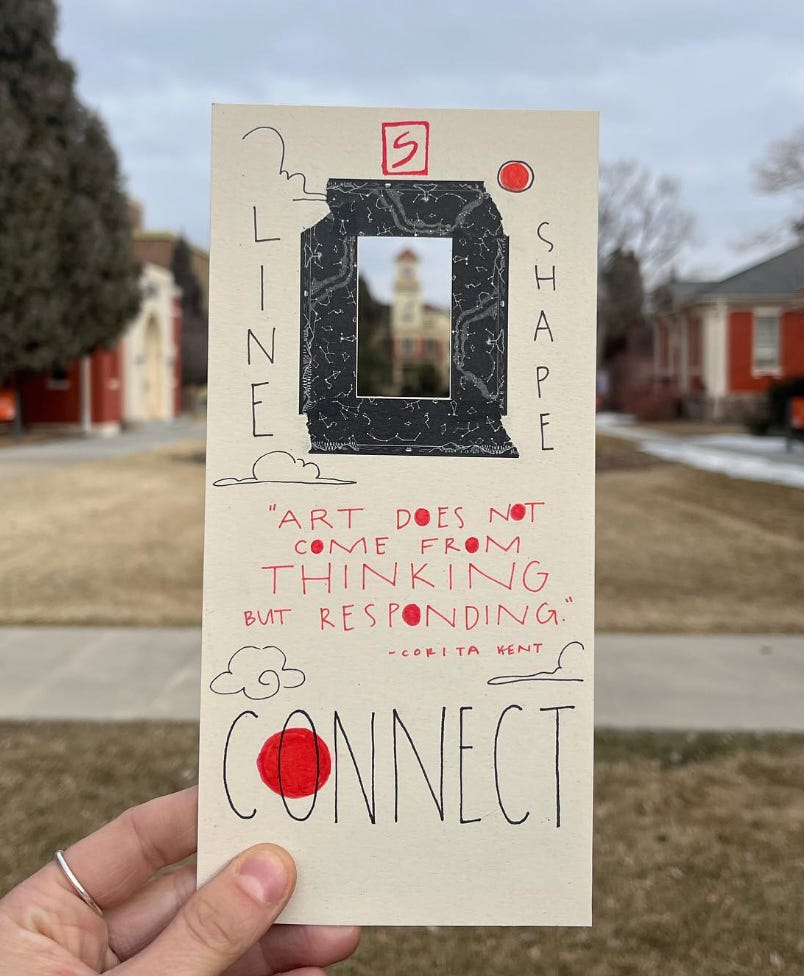". . . It’s meant to be a workbook" (p. 11).
While reading is important to learning and growth - this book is really meant to be an exercise in creative self-discovery. That takes dedication to process and well, time. That’s what I encourage you to do this week.
This week I want to encourage you to choose any assignment from Chapter 2: Looking (p. 13-40) and do it!
Honestly when reading that chapter, Corita echoes of “do it” are loud and clear (p. 15, 16). In chapter one, LOOKING, I get excited with what this text is inviting us to do. She’s taking us along on a journey into one's own creative process, asking where does our creativity come from? To Corita, you can discover this through your looking skills. Her assignments in this chapter are simple, yet constantly growing practices in using drawing as a way to connect to the world around us - “actively developing our seeing muscles” something that takes “constant, disciplined use” (p. 33). While also sharing that nonsense is a valuable contribution to one’s sense diary (19).
For my assignment challenge, I completed the assignments on page 24 with the chair and one on page 16 with shadows. These drawings also led me to taking photos of the shadows drawn as well, as I too agree with Charles Eames that “a camera should be as common a tool as a pencil, not just for recording, but for framing pictures and examining details” (p. 26).
Which also led me to learning a lot about Polaroid photography, thanks Mr. Eames,
Truly, I love how each chapter in this book kicks off creative exploration in my journal and thought connections.
How are you connecting with this week’s theme, LOOKING?
What can this chapter help you consider when reflecting on your own creative process?
This time when I read “the child is quite right” on page 14 I had a revelation. We often know at a very young age what makes us excited. For me, drawing was what I gravitated towards always.
Is Corita saying that our childhood curiosities are right? I like to think so.
While the act of looking can be made fresh by taking a childlike wonder, I want to imagine it's a permission to reflect on those childhood intrinsic pulls. They may after all be helpful in how you view and make visible your own creative process.
If you feel comfortable, please share any images of your visual journal or assignments in this google drive folder. Please make sure to title your .JPEG files with your Name and Chapter (i.e. Slu_Looking). With your permission, I’d love to share with our group. Woohoo thanks subscribers!
creative exercise: make a finder
timeframe: 20-40 Minutes
materials: cardstock, scissors, found materials, and favorite mark-making items.
steps:
PREPARE: Following Corita’s Assignment on Pg. 26, brainstorm your version of the “finder”
INCUBATE: CREATE your Finder
INSIGHT: GO EXPLORE! Take your viewfinder for a 10 Minute Walk.
Look for interesting connections and compositions
EVALUATION: Choose a final spot and create (10) Viewfinder Composition Thumbnails.
ELABORATION: Choose your favorite one & sketch in a final composition. Add color!








I’m slowing starting to read the book, and one of the aspects that’s has particular stuck with me in Corita’s practice is to play - and how it feels different and similar to Eames approach to play. (I also didn’t realize they knew each other until you mentioned it.) And you’re right all the assignments encourage curiosity and exploration - and just trying it out! I love that approach to creativity.